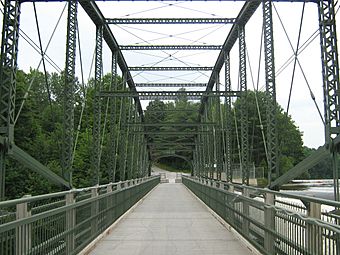- This page was last modified on 17 October 2025, at 10:18. Suggest an edit.
Douglas & Jarvis Patent Parabolic Truss Iron Bridge facts for kids
|
Douglas & Jarvis Patent Parabolic Truss Iron Bridge
|
|
 |
|
| Location | Mill Hill Rd., Highgate, Vermont |
|---|---|
| Area | less than one acre |
| Built | 1887 |
| Built by | The Berlin Iron Bridge Company; Douglas & Jarvis |
| Architectural style | Parabolic Truss Iron |
| NRHP reference No. | 74000213 |
| Added to NRHP | March 21, 1974 |
The Douglas & Jarvis Patent Parabolic Truss Iron Bridge is a really old and important bridge in Highgate, Vermont. It crosses the Missisquoi River. This bridge is special because of its unique design. It was built way back in 1887. In 1974, it was added to the National Register of Historic Places. This means it's a very important landmark in American history.
Contents
What is the Douglas & Jarvis Bridge?
The Douglas & Jarvis Patent Parabolic Truss Iron Bridge is found near Highgate Falls village. It sits at the end of Mill Hill Road. Long ago, it helped people cross the Missisquoi River. Now, it's a special bridge just for people to walk on.
How Long is This Historic Bridge?
This amazing bridge is about 215 feet (66 meters) long. That makes it one of the longest bridges of its kind in the northeastern United States! It rests on strong stone supports called abutments.
What Does a Parabolic Truss Bridge Look Like?
The bridge has a unique shape called a "parabolic" or "lenticular" truss design. Imagine the shape of a lens, like in glasses or a camera. That's what the main parts of the bridge look like! These curved parts help make the bridge super strong.
The main curved sections are held up by tall iron posts. These posts have cool decorations on top called finials. All the parts are connected by a network of iron rods overhead. This design makes the bridge both strong and beautiful.
Who Built This Special Bridge?
The Douglas & Jarvis Patent Parabolic Truss Iron Bridge was built in 1887. It was made by a company called the Berlin Iron Bridge Company. This company was from Berlin, Connecticut. They had a special "patent" for the lenticular truss design. A patent is like a special permission that says only they could use this unique design for a while.
Why is This Bridge Important?
This bridge was one of the first in Vermont to get money from the state to help build it. It's also one of the biggest lenticular truss bridges still standing in the northeastern United States. The Berlin Iron Bridge Company built many bridges with this design. But over time, they stopped using it. This makes the Douglas & Jarvis bridge a rare and important example of old bridge building.

